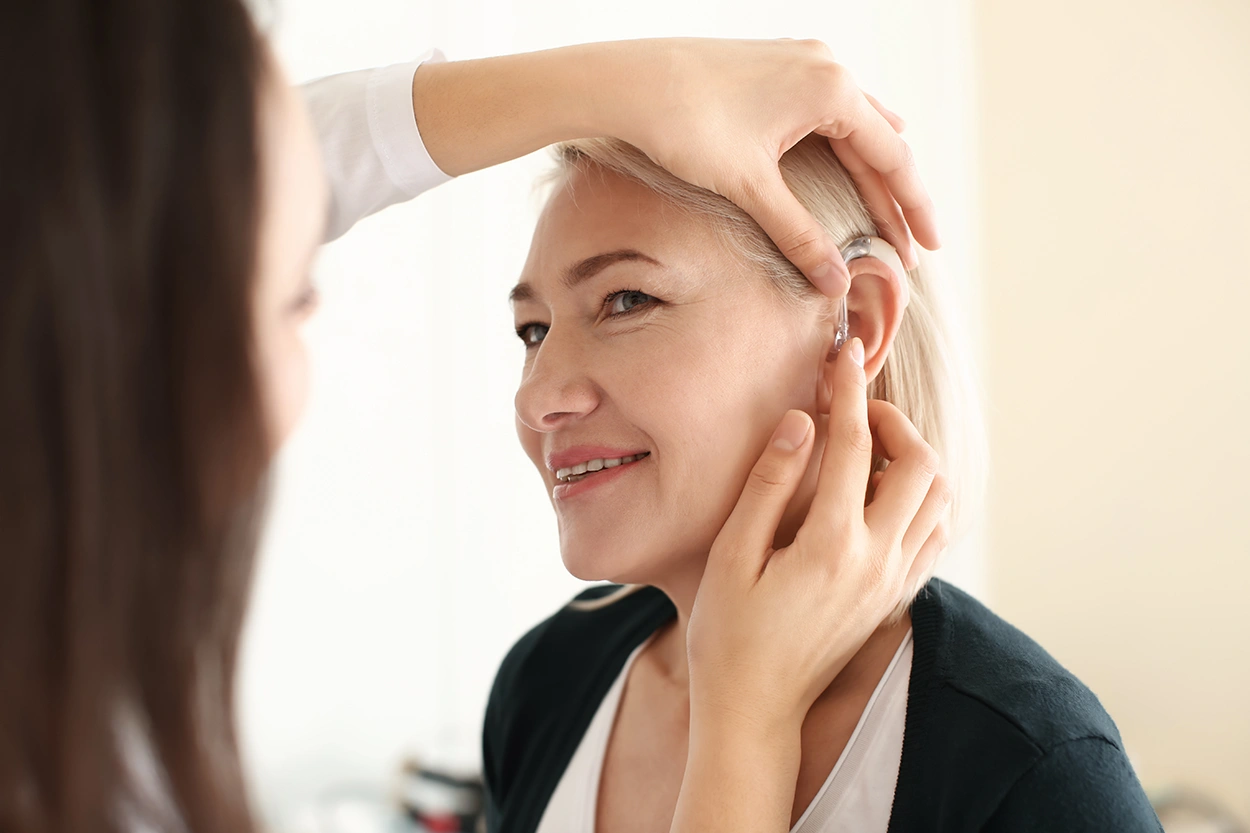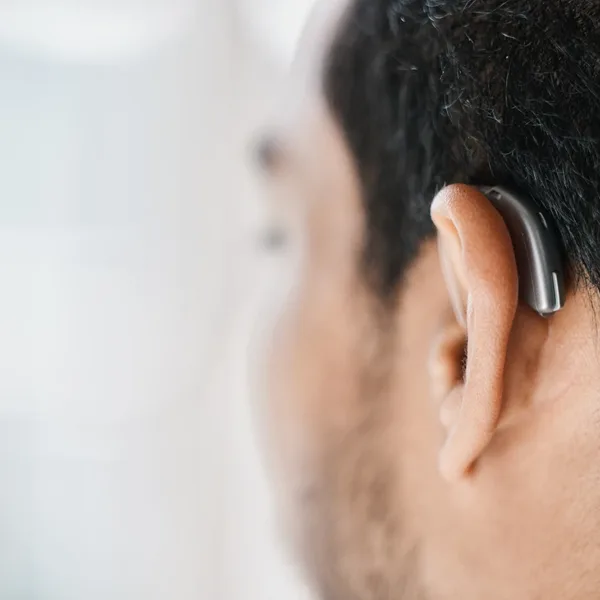
Today’s hearing aids are more advanced than ever before. But they don’t come perfectly tuned to your needs right out of the box. Just like eyeglasses need the right lenses, prescription hearing devices are customized to your specific hearing needs. That’s where hearing aid programming comes in.
In this guide, we explain what hearing aid programming is, how it works, and why it plays such a crucial role in your hearing experience.
Hearing Aid Programming Explained
While many hearing aids come preloaded with general settings, those defaults rarely match the specific hearing needs of an individual. That’s where programming makes all the difference.
Hearing aid programming is the process of customizing your devices to support your unique hearing needs, lifestyle, and listening preferences. Everyone’s hearing profile is unique, and programming ensures that your device is optimized for the best possible performance.
This process is performed by your hearing care specialist, using the results of your comprehensive hearing test (called an audiogram). Your specialist adjusts the amplification, frequency, noise reduction, and other settings to ensure you can hear clearly in real-world situations.
Once your base settings are programmed, we can take customization a step further with custom hearing aid modes:
Custom Hearing Aid Modes
Custom hearing aid modes are personalized listening modes designed to help you hear better in specific environments. They are created to optimize device performance in situations you encounter in your daily life. Each mode processes sound differently based on your hearing needs in those specific instances.
Examples of custom hearing aid programs include:
- Noisy Mode: Enhance speech clarity while reducing background noise.
- Quiet/Home Mode: Gentle amplification designed for optimal listening in calm settings.
- Outdoor/Windy Mode: Reduce wind noise while adjusting for environmental sounds.
- Car or Traveling Mode: Enhancing important sounds like passengers speaking and GPS navigation alerts, while suppressing loud road noise.
- Work or Meetings Mode: Enhance the speech of one person in environments with multiple speakers.
- Phone Mode: Enhanced speech during phone calls.
Switching between these custom programs is incredibly simple. Some devices have a physical button that you press, Bluetooth hearing aids often have smartphone apps, and wireless hearing aid remotes allow you to easily switch between programs.
Why Personalized Programming Matters
Everyone experiences hearing loss differently. Some people have trouble hearing higher-pitched sounds, like birds chirping or children’s voices, while others struggle to follow conversations in noisy places. Hearing aid programming allows your specialist to tailor your device to your unique hearing needs.
This gives you many benefits, including:
- Improved speech clarity: Fine-tuned settings make it easier to follow conversations, even in noisy environments.
- Natural sound quality: Proper programming reduces distortion and enhances overall listening comfort.
- Reduced listening fatigue: The right settings can help your brain process sound more efficiently, reducing the brain power required to hear.
- Ongoing adaptability: If your hearing needs, daily routine, or preferences change, you can always get your hearing aids reprogrammed to meet these needs.
Without programming, a hearing device just functions as a sound amplifier that makes everything louder, including the sounds you don’t want to hear. But with the right programming, your hearing aids know what to focus on, like voices in a conversation, and what to tone down, like background chatter.
How Are Hearing Aids Programmed?
Below, we outline the step-by-step process of how prescription hearing aids are programmed:
1. Get a Comprehensive Hearing Test
The first step in programming a hearing aid is a comprehensive hearing test. This test measures how well you hear sounds at different pitches and volumes, and the results are shown on a graph called an audiogram.
Think of this audiogram as a map of your hearing. Your specialist uses this map to program your hearing aids, so they amplify the sounds you struggle to hear, without over-amplifying the ones you don’t.
2. Programming Your Base Settings
Once your hearing test is complete, your specialist can program your hearing aids using specialized software. One of the most important parts of this process is adjusting how much your hearing aids amplify sound (gain) and how loud they allow certain sounds to get (output):
- Gain refers to the amount of amplification applied to different sound frequencies. For example, if it is harder for you to hear higher-pitched speech sounds like “s” and “t”, your specialist will program more gain in that range so you can hear them more clearly.
- Output is the maximum volume your hearing aids will allow. This ensures that loud sounds (like a barking dog or a passing siren) don’t become uncomfortably loud or dangerous to your hearing.
If your hearing device has features like noise reduction, wind suppression, feedback management, or microphone directionality, your specialist will also adjust these. These settings help filter out noisy distractions and focus on the sounds that matter most.
3. In-Office Listening Tests
After the initial settings are programmed, you’ll then try them out through a series of listening tests. These are designed to check how the adjustments actually sound to you and identify any areas where the quality or clarity could be improved. Based on your feedback from these tests, your hearing care provider will make any final adjustments to your device settings.
In some cases, your specialist may also use a technique called Real-Ear Measurements (REM). This involves placing a tiny microphone in your ear canal to measure how sound actually behaves inside your ear while you’re wearing your hearing aids.
4. Real-World Testing and Follow-Up
No programming session can fully predict how things will sound in every environment. The real test comes when you wear your hearing aids out in the world, like at work, at home, in restaurants, or while watching TV.
This is why after your initial hearing aid fitting your specialist will have you come back in for a follow-up visit. Based on your real-life experiences and feedback about what sounded great, what didn’t, and what situations felt challenging, your specialist will make further adjustments.
5. Reprogramming as Your Needs Change
Over time, as your hearing needs or lifestyle changes, or if you encounter new listening challenges, your hearing aid can be reprogrammed by your specialist. This ongoing support ensures your hearing aids continue to provide optimal comfort and performance long-term.
Find the Personalized Hearing Solutions You Deserve at Audibel
Hearing loss is unique to everyone. Unless your hearing aids are programmed specifically for your needs, you won’t get the clarity or comfort you deserve. At Audibel clinics, we use advanced software and real-world feedback to fine-tune your devices with care and precision. This ensures they support you in the moments that matter most.
Find an Audibel clinic near you to schedule an appointment with one of our hearing care specialists.






Have a question or Comment?